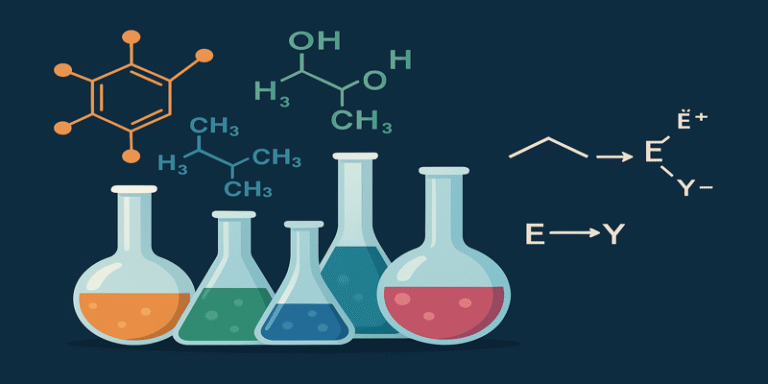Among the many branches of chemistry, organic chemistry holds a distinctive position as the study of carbon-based compounds and the molecular frameworks that make life possible. Its relevance stretches far beyond the confines of the laboratory; it underpins the functioning of biological systems, the synthesis of medicinal drugs, the creation of plastic materials, and even the design of fragrances and dyes. The breadth and complexity of this subject make it both intellectually stimulating and practically indispensable.
Foundations of Organic Chemistry
At its core, organic chemistry is the discipline that investigates the structure, properties, composition, reactions, and synthesis of compounds primarily composed of carbon atoms. The unique ability of carbon to form four covalent bonds and to bond with other carbon atoms allows for a remarkable diversity of molecular architectures—from simple methane (CH₄) to complex proteins and DNA.
Carbon’s bonding versatility is further enhanced by its interactions with elements like hydrogen, oxygen, nitrogen, sulphur, and halogens. This allows for the formation of functional groups—specific arrangements of atoms that define a compound’s chemical behaviour. For example, alcohols, aldehydes, ketones, amines, and carboxylic acids all possess unique functional groups that determine their reactivity and interactions.
According to Clayden et al. (2012), mastering organic chemistry means developing a keen ability to recognise patterns of reactivity and to apply general principles to predict reaction outcomes. This makes the subject an essential component of a chemist’s training.
Key Topics Within the Module
1.0 Nomenclature and Structure
Learning to name and draw organic compounds is foundational. Students begin by understanding the International Union of Pure and Applied Chemistry (IUPAC) rules for naming hydrocarbons and substituted derivatives. From there, they explore molecular structure, including concepts such as isomerism—compounds with the same molecular formula but different arrangements.
Stereochemistry, or the study of spatial arrangements of atoms, is crucial in organic chemistry. The chirality of molecules—particularly in pharmaceuticals—can determine whether a compound is therapeutic or harmful (Eliel & Wilen, 1994).
2.0 Reaction Mechanisms
Organic reactions are often presented as mechanisms, depicting the stepwise movement of electrons. These include reactions such as:
- Nucleophilic substitution (SN1 and SN2)
- Electrophilic addition
- Elimination reactions (E1 and E2)
- Radical reactions
- Pericyclic reactions
Understanding these mechanisms enables chemists to predict and design new reactions. As Smith (2020) explains, reaction mechanisms provide a visual and conceptual language that guides organic synthesis.
3.0 Spectroscopy and Characterisation
Identifying organic molecules requires the use of spectroscopic techniques, including:
- Infrared (IR) spectroscopy – identifies functional groups based on molecular vibrations
- Nuclear Magnetic Resonance (NMR) spectroscopy – provides information about the number and environment of hydrogen and carbon atoms
- Mass spectrometry (MS) – determines molecular weight and fragmentation patterns
These tools are vital for determining molecular structure and purity, especially in research and industrial settings (Pavia et al., 2014).
Applications Across Industries
The utility of organic chemistry is most evident in its wide-ranging applications.
1.0 Pharmaceuticals
Perhaps the most prominent application is in the design and synthesis of drugs. Organic chemists modify molecular structures to create compounds with desired biological activity, minimal side effects, and efficient metabolic profiles.
For example, the synthesis of aspirin, paracetamol, and penicillin involves precise manipulation of organic molecules. Medicinal chemistry, a subfield of organic chemistry, works in tandem with pharmacology and biochemistry to produce life-saving medications (Silverman & Holladay, 2014).
2.0 Petrochemicals and Polymers
The petrochemical industry relies heavily on organic chemistry to convert crude oil into useful products such as plastics, fuels, and solvents. The synthesis of polymers like polyethylene, polystyrene, and polyvinyl chloride (PVC) is based on the principles of chain-growth polymerisation, a core concept in organic chemistry.
Additionally, green chemistry approaches have emerged, using organic principles to reduce environmental impact during production (Anastas & Warner, 1998).
3.0 Agrochemicals
Fertilisers, pesticides, and herbicides are all products of organic chemistry. Compounds are carefully designed to optimise efficacy, environmental compatibility, and degradability. New-generation agrochemicals aim to be more target-specific while reducing harm to non-target organisms.
4.0 Material Science
Organic chemistry contributes to the development of conductive polymers, OLED displays, and biodegradable plastics. Functional organic molecules are now at the forefront of nanotechnology and flexible electronics (Bergman, 2016).
Organic Chemistry in Academia
Due to its conceptual complexity, organic chemistry is often considered a challenging subject. Students must develop skills in spatial visualisation, logical reasoning, and problem-solving. Mohan (2016) suggests that performance in organic chemistry is closely linked to students’ ability to think in three dimensions and to understand reaction patterns, rather than memorising isolated facts.
Laboratory training is a critical component, where students perform syntheses, monitor reactions, and use spectroscopy to analyse products. These skills are directly transferable to roles in research, industry, and regulatory science.
Modern Trends and Innovations
Modern organic chemistry is increasingly supported by computational tools that predict molecular properties and reaction pathways. Machine learning is now used to design novel synthetic routes, while automated synthesisers are accelerating drug discovery (Schwaller et al., 2019).
Furthermore, sustainable synthesis is gaining prominence. Techniques such as microwave-assisted synthesis, biocatalysis, and photoredox catalysis are making organic chemistry greener and more efficient (Sheldon, 2017).
The Role of Organic Chemistry in Society
Organic chemistry is deeply embedded in daily life. From the soaps and detergents in our homes to the dyes in our clothing and the preservatives in our food, the work of organic chemists is everywhere. Importantly, this field plays a central role in addressing global challenges such as antibiotic resistance, renewable energy, and sustainable agriculture.
As we move toward a bio-based economy, the demand for expertise in organic chemistry will only grow, requiring not only technical knowledge but also ethical and environmental awareness.
Organic chemistry is a vibrant and multifaceted field that lies at the intersection of science and society. Its study offers a profound understanding of the molecular building blocks of life and provides the foundation for advances in medicine, industry, agriculture, and environmental science. By mastering the principles of structure, reactivity, and analysis, organic chemists continue to shape the materials, technologies, and medicines that define modern civilisation.
Despite its complexity, organic chemistry remains one of the most rewarding disciplines in science—offering endless opportunities for creativity, discovery, and real-world impact.
References
Anastas, P. T. & Warner, J. C. (1998). Green Chemistry: Theory and Practice. Oxford University Press.
Bergman, R. G. (2016). Organic Chemistry: Concepts and Applications. University Science Books.
Clayden, J., Greeves, N., Warren, S. & Wothers, P. (2012). Organic Chemistry. Oxford University Press.
Eliel, E. L. & Wilen, S. H. (1994). Stereochemistry of Organic Compounds. Wiley.
Mohan, J. (2016). Organic Chemistry (3rd ed.). Oxford University Press.
Pavia, D. L., Lampman, G. M., Kriz, G. S. & Vyvyan, J. R. (2014). Introduction to Spectroscopy (5th ed.). Cengage Learning.
Schwaller, P., Laino, T., Gaudin, T., Bolgar, P., Hunter, C. A., Bekas, C. & Lee, A. A. (2019). “Molecular Transformer: A Model for Uncertainty-Calibrated Chemical Reaction Prediction”. ACS Central Science, 5(9), pp. 1572–1583.
Sheldon, R. A. (2017). “The E factor 25 years on: the rise of green chemistry and sustainability”. Green Chemistry, 19(1), pp. 18–43.
Silverman, R. B. & Holladay, M. W. (2014). The Organic Chemistry of Drug Design and Drug Action (3rd ed.). Academic Press.
Smith, J. G. (2020). Organic Chemistry (6th ed.). McGraw-Hill Education.









